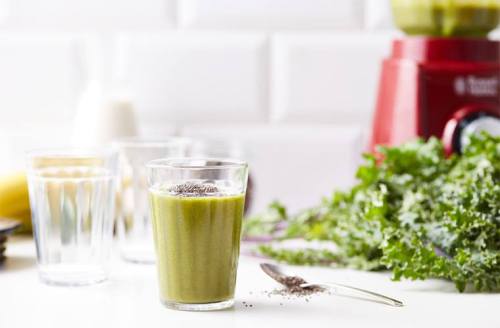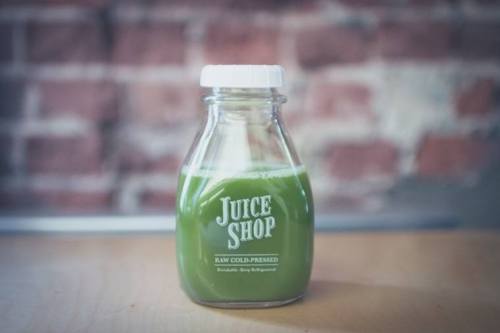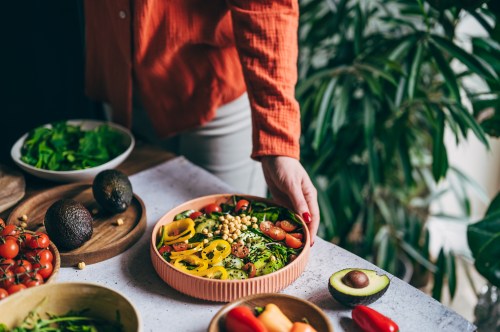Our editors independently select these products. Making a purchase through our links may earn Well+Good a commission
Green juice vs. green powder: How they really compare
Find out what's healthier, green juice or green powder, plus what tastes better.

“Eat more greens” used to be a simple directive, but these days, there are lots of ways to get your daily dose of kale. When we tapped our virtual Rolodex of nutritionists to ask them which is best, they all joined in a resounding chorus of “Eat them whole!” We know, we know.
But everyone has days when they’re just too busy to make a salad or when fresh veggies are nowhere to be found. Even on good days, it’s hard to fit in all of those servings, so it’s often nice to supplement with a cold-pressed juice or a greens powder packet.
But, just how virtuous are we being, we wondered? And how does green juice stack up against green powder? We sorted through the nutritional facts—and assumptions—with help from superstar nutritionists, and came away with some surprising findings. Here’s what you need to know…
Keep reading how green juices and green powders really compare.

Absorption of Nutrients
Drinking fresh juice is like giving yourself a nutrient shot. Since the veggies are partially digested, your body can soak them up quickly. “The fibrous parts of the plants have been removed, and the cell walls are broken down allowing the enzymes that our bodies produce to easily act on these nutrients,” says Amy Shapiro, a registered dietican and founder of Real Nutrition NYC.
Your body should also easily process fine powders, although studies have shown that they may not retain some of the important enzymes needed for absorption. Some brands say their process has effectively preserved them, but there’s really no way to confirm this claim.

Fiber
Veggies are fabulously fibrous, but breaking them down into powder or juice can ruin that. “Green powders have minimal, if any, fiber because the amount of the product consumed is so small and concentrated,” says Shapiro, so you shouldn’t really consider powders a source for fiber. (Amazing Grass Green Superfood, for example, has just two grams per serving.)
Juices that are cold-pressed or made using traditional centrifugal juicers are mostly stripped of their fiber. But there’s a way to hold onto some pulp if you’re juicing at home. On the other hand, “blenders like the Vitamix pulverize the greens [and don’t remove any of the pulp], so you get your juice but keep the fiber,” explains Brooke Kalanick, a naturopathic doctor and co-author of Ultimate You.

Calories and Sugar
Powders generally have less calories than juices (around 30), compared to 200 and up in juices. But while those are mainly “good calories” from produce that the body needs, sugar can be an issue with juice if its light on greens and high in fruit.
“An eight ounce serving of fruit-and-green juice contains about 130 calories and 22 grams of sugar—equivalent to about four and a half teaspoons of added sugar,” says Shapiro.
And, says, Dr. Kalanick, “The fruits especially become more of a blood sugar mess when we remove the fiber.” Note to those who have sugar sensitivities and hypoglycemic mood swings!

Quality
Not all juices and powders are created equal. Dr. Kalanick recommends choosing a powder that’s at least 50 percent organic and was processed with protection from UV light, heat, and moisture (which ensures that the chlorophyll and nutrient content is maintained). You should also avoid brands that have a lot of ‘fillers” such as lecithin, fibers, whole grasses, pectin, rice bran or flax.
Freshness matters too. “It is best to drink a fresh juice immediately after making because as soon as it’s made it begins to lose certain nutrients,” says Shapiro.
And quality powders are raw and dehydrated, so they should be stored in cool, dry places to prevent mold or nutrient loss from light and heat exposure.

Taste
Juices have lots of variety, and if the greens taste is too much for you, you can add (a little!) fruit, ginger, or lemon. Even celery and cucumber can help.
Powders vary. We’ve had awful sweet versions, awful bland versions, and also those that taste pretty damn good. (Some of our faves include those with goji berry, pomegranate, and other red fruit extracts.) But even the best don’t compare to the super-fresh taste of a good juice.

Winner
Juice, heavy on greens—and made in a Vitamix for the fiber with the plant-based nutrients. Dr. Kalanick offers this summary: “My recommendations would be: whole, fresh organic greens at every meal (yes, even breakfast). Next up would be a fresh greens-only juice or, if mixed with fruit, have it with a protein-based meal to keep blood sugar even. Have a high quality, organically-sourced greens powder for those days when you just weren’t able to get all those veggies in or are on the road.”
Need a healthy smoothie recommendation? These three will get you out of your rut. And if you’re un a budget, these recipes are super affordable.
Sign Up for Our Daily Newsletter
Get all the latest in wellness, trends, food, fitness, beauty, and more delivered right to your inbox.
Got it, you've been added to our email list.









